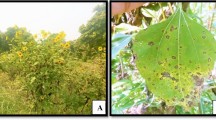Abstract
DNA was extracted from the strain of pathogen of poplar leaf blight using a modified CTAB method. ITS sequence (601bp) was initially amplified from the pathogen by using the universal primers ITS1 and ITS4 (registered No. DQ011257). Comparing to the nucleotide sequences acquired from GenBank database, the strain is clustered into the homogeneity with Alternaria alternate (AY787684) and Alternaria alternate (AY354228), with a homology of 98%, thus the strain was checked as Alternaria alternata (Fr.) Keissler. The optimal conditions for conidia germination and mycelium growth of the pathogen were tested. The optimal temperature for conidia germinating and mycelium growth is 25°C, and the optimal pH value is 6. Mycelium grows rather slowly at 10 °C and 30 °C and growth stops at above 35 °C. Among the six culture mediums tested, PDA + poplar leaf juice medium is most favorable for mycelium growth.
Similar content being viewed by others
References
Dong Xiliang, Huang Wenxiu. 1994. Pathogen of Cedar leaf scorch and its biological characters [J]. Acta Agriculturae Boreali-Sinica, 9(3): 76–80. (in Chinese)
Lou Binggan, Xia Xiaodong, Lou Xiaoming. 2002. Studies on needle blight of Pinus parviflora in Hangzhou [J]. Journal of Zhejiang Agriculture, 14(5): 269–272. (in Chinese)
Lv Qingru, Cai Jiwen, Wei Dongying. 1999. Preliminary study on leaf spot of Sugar Maple. Forest Pest and Disease, (1): 28–29. (in Chinese)
Septo-Schubert, R, Bahnweg, G, Nechwatal, J, et al. 1999. Detection and quantification of Phytopthora species which are associated with root-rot diseases in European deciduous forests by species-specific polymerase chain reaction [J]. Eur. J. for Path, 29: 169–188.
Wang Chunjiang, Shang Hongsheng, Wang xu. 2000. Study on biological characters of Alternaria triticina Prasada and Prabhu [J]. Journal of Northwest Agricultural University, 28(3): 7–10. (in Chinese)
Wang Hongkai, Zhang Tianyu, Zhang Meng. 2001. Application of sequencing of 5.8S rDNA, ITS1 and ITS2 on identification and classification of Alternaria at species level [J]. Mycosystem, 20(2): 168–173. (in Chinese)
Wang Shutong, Cao Keqiang, Hu Tongle, et al. 2004. Evaluation of the extracting methods for Flossyzygii aromatici and Herba asari extracts which showed inhibitory effects against Botrytis cinerea [J]. Journal of Hebei Agricultural University, 27(1): 69–72. (in Chinese)
Xiang Cundi. 1991. The research methods for forest disease [M]. Harbin: Northeast Forestry University Press. (in Chinese)
Xing Xiaoke, Guo Shunxing. 2004. Study on phylogenetic relationships of Grifola umbellata and its companion fungi by ITS sequence analysis [J]. Microbiology, 31(2): 34–36. (in Chinese)
Xu Shuqin, Sun Lianjun. 1986. The study on poplar mycosis [J]. Journal of Northeast Forestry University, 14(1): 56–63. (in Chinese)
Zhao Jie. 2004. ITS sequence analyze and its application on molecular detecting of plant epiphyte disease [J]. Journal of Shanxi Agricultural Sciences, (4): 35–37. (in Chinese)
Author information
Authors and Affiliations
Corresponding author
Additional information
Foundation item: This paper was supported by National Natural Science Foundation of China (No.30271083).
Biography: JI Hong-fang (1978–), female, Ph.D. candidate of Biology Science and Technology Department, Harbin Institute of Technology, Harbin 150001, P. R. China.
Rights and permissions
About this article
Cite this article
Ji, Hf., Yang, Q. & Song, Rq. Biological characters and rDNA ITS sequences of pathogen of poplar leaf blight. J. of For. Res. 17, 17–20 (2006). https://doi.org/10.1007/s11676-006-0004-6
Received:
Accepted:
Issue Date:
DOI: https://doi.org/10.1007/s11676-006-0004-6




